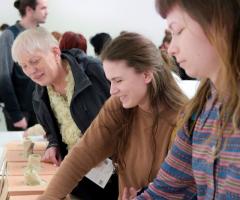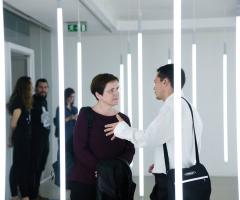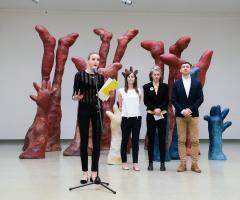LIKE AT HOME: Model Situation of Slovak Sculpture in the 20th and 21st Century
1st floor of KHB
Exhibition view // Photo © archive of KHB / Adam Šakový
Opening:
March 30th 2017
from 6 p.m. untill 8 p.m.
Duration:
March 31th 2017 – October 29th 2017
Venue:
1st floor of KHB / Central Hall
Exhibiting artists: Maria Bartuszová, Juraj Bartusz, Marko Blažo, Tomáš Džadoň, Jozef Jankovič, Marek Kvetan, Juraj Meliš, Michal Moravčík, Martin Piaček, Karol Pichler, Pavla Sceranková, Emöke Vargová
According to its definition, sculpture operates with material, space, and time. Art theory strives to analyze which of the three dimension of sculpture identity is essential and crucial in different periods of the evolution of art. Among other factors, the art created in 1960s was marked by dematerialization and intermedia extensions. Once the period of misusing monumental sculpture for totalitarian purposes was over, our art faced a significant “fleeing” of sculpture from the discourse of public space, losing its value in social and political life. On top of that, it suffered from the absence of artistic quality required by the new architecture.
The familiar title of the exhibition refers to certain subject matters of contemporary sculpture and connotes interinstitutional relations of conservative institutions like the Slovak National Gallery and Kunsthalle Bratislava, which discuss new and current artistic concepts from Slovakia and abroad. The exhibition presents works mostly of domestic origin and from domestic collections. The pieces from the collection of the Slovak National Gallery – which lost a significant part of exhibition space due to ongoing reconstruction – dominate the exhibition in terms of size and scope. Undoubtedly, the collection of SNG belongs to long-term and conceptually formed collections. For many years, however, there was no adequate way of exhibiting it in the extent required by this kind of art. The title of the exhibition can be interpreted through the subject matters and materials of the exhibited pieces. One of the current installations presents a panel house by Tomáš Džadoň, several spatial objects and installations composed of household utilities including furniture[1] and banal objects of private space. We must realize, though, that the objects not only define us, but also organize, animate and initiate context relations. The objects have performative and transformative power that manifests individually and among each other.[2] The same applies for the artworks that together create new, different stories, contexts and relations, which would not emerge without their joint arrangement in space, i.e. without exhibiting them together.
The aim of the exhibition is to present at once in a single room the selected artworks of rather monumental dimensions, due to which they stayed unexhibited in depositaries for a relatively long time. The large size and challenging installation practically disqualified these pieces, which were typically introduced only through reproductions and other records. When it comes to perceiving visual art, though, physical experience is vital, especially in case of sculpture. According to the American theorist and curator Johanna Burton, sculpture is defined by a circular motion around it, making it impossible to capture the entire artwork at once.[3] The selected monumental works are related to architecture, particularly Jozef Jankovič's vertical objects, Tomáš Džadoň's panel house, Michal Moravčík's installation evoking a gate and also a tower. The first two utilize stable objects to depict lability, drama, and impending disaster. Sculpture as a construction (or a composition) is built on the principles of composing different elements, as well as on tectonic principle. The fusion of architectural and sculptural tendencies was introduced by the essential exhibition Form Follows... Risk[4] considered as a turning point in the interpretation of contemporary sculpture in our context.
In one room, artworks from 1960s encounter with contemporary pieces created recently by the authors of the middle and younger generation. Their composition in space – or the production of the exhibition – was created with respect to the exhibition needs of the monumental pieces, as well as by “mixing and matching”.[5] The artworks are arranged intuitively, randomly, subjectively and ahistorically, without style and material limits, preferring recent acquisitions and pieces that were not physically introduced and exhibited for a long time. It is true, though, that it was possible to show only a small fragment of the collection. Primarily, the works come from the collection of the Slovak National Gallery, the selection of which is accompanied by some pieces from the authors and the collections of other galleries, specifying the theme of the exhibition generated by and revealed through the exhibits. The works do not function as illustrations of the idea – they de facto determine it. Although not intentionally, the installation and the selection evoke an absent, vanishing body. The scene comes to life as the visitors move through it, becoming an active part of the installation.
The exhibition was not preceded by a long-term concentrated research on historical and theoretical evolution of sculpture in Slovak art. However, the creation of a collection can be seen as the result of a systematic research executed by a number of experts over several decades of the existence of the gallery.[6] We have consciously tried to avoid including the works that require a plinth as a traditional installation element related to sculpture, so that the pieces work autonomously – directly on the floor or on the wall, naturally blending with the exhibition space. The art of installation employs a certain degree of performativity, introducing different artistic styles, forms, languages, and expressions at once in the same space. The approach to the selection and the final form of the exhibition remains open, free of limitations and boundaries, with the exception of (the term) sculpture – to present its historical evolution without other media would probably be vain.
Vladimíra Büngerová
Expert collaboration
[1]In 2002 – 2003 an exhibition entitled NYBŰVITT – Furniture in Contemporary Art took place in the synagogue of Ján Koniarek Gallery in Trnava. The show presented several authors of installations and objects based on furniture (curators: Petra Hanáková, Alexandra Kusá).
[2]Jeřábková, Edith: Rozšírený editoriál. In: Jeřábková, Edith – Lang, Dominik (eds.): Lapidárium. Ateliér sochařství. Prague: Academy of Arts, Architecture and Design, 2014, p. 20.
[3]Burtonová, Johanna: Sochařství: Ne-Ne-Ne (Nebo krásný vzduch). In: Jeřábková, Edith – Lang, Dominik (eds.): Lapidárium. Ateliér sochařství. Prague: Academy of Arts, Architecture and Design, 2014, p. 94
[4]Center for Contemporary Art Futura and Karlin Studios, Prague and Slovak National Gallery, Bratislava, 2007, curators: Jana Ševčíková, Jiří Ševčík, Monika Mitášová.
[5]Kulatý stůl/Dilema současného umění. In: Foster, Hal – Krauss, Rosalind – Bois, Yve-Alain – Buchloh, Benjamin H. D.: Umění po roce 1900. Modernismus, antimodernismus, postmodernismus. Bratislava : Slovart, 2007.
[6]Among others, the collection of modern and contemporary sculpture was curated by Denisa Kahounová, Zuzana Bartošová, and Zora Rusinová.
- - - - -
- - - - -































